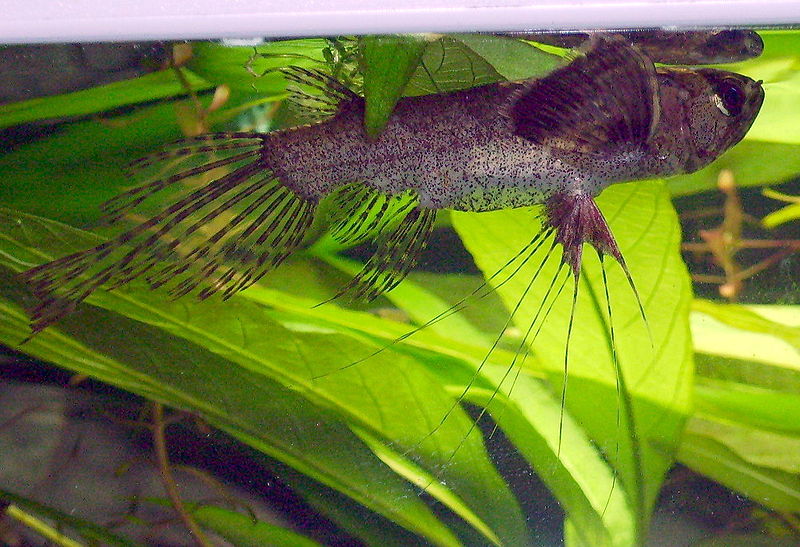Hello, Frank Indiviglio here. Anyone with an outdoor swimming pool is aware of the vast numbers of insects that continually crawl into or alight upon the water. If you now consider how many billions of terrestrial insects find their way into the world’s fresh and marine waters each day, you will quickly realize that fishes have ample opportunity to consume a food item that is not usually included in captive diets (and lets not forget about the millions of aquatic insect species). Small wonder that earthworms, crickets and waxworms are among the most effective fishing baits known.
An Overlooked Resource
 However, while the sale of live and canned insects to reptile owners has long been a booming business, aquarists have largely disregarded insects as a food source for fishes. Even well-known insect specialists such as African butterfly fishes (please see photo), mudskippers and archer fishes are rarely provided with the invertebrate-rich diets they favor.
However, while the sale of live and canned insects to reptile owners has long been a booming business, aquarists have largely disregarded insects as a food source for fishes. Even well-known insect specialists such as African butterfly fishes (please see photo), mudskippers and archer fishes are rarely provided with the invertebrate-rich diets they favor.
My Introduction to Insects as Fish Food
I first became aware of just how much fishes favored insects quite by accident. As a youth I constantly experimented with mixed species “shoreline” type aqua-terrariums…green treefrogs living on branches above guppies, bronze frogs with pumpkinseed sunfishes and so on.
I noticed that crickets which fell into the water were set upon ravenously by whatever fishes happened to be nearby. Dead, water-softened crickets elicited a feeding frenzy among even the most “peaceful” of fish species, such as guppies, Cory cats, platys and swordtails.
Using Live and Canned Insects
I soon found insects to be eagerly accepted by many typical (and untypical!) aquarium fishes, including freshwater, marine and brackish species. I continue to use substantial numbers of insects as food for a wide variety of fishes, and believe that the vigor, color and health of many has benefitted as a result. Increased feedings of insects and similar foods may also be useful in bringing certain freshwater species into breeding condition.
Canned invertebrates offer a convenient method of providing your fishes with valuable dietary variety. Next time we’ll take a look at their role in fish–keeping and some other examples of insect-feeding among wild fishes. Until then, please write in with your questions and comments. Thanks, until next time, Frank Indiviglio.
Further Reading
The archer fish feeds almost entirely upon terrestrial insects, knocking them from vegetation with well-aimed jets of water. By specializing so, it is able to exploit a unique food source in a habitat teeming with competing species. The Friends of the National Zoo has posted information on their care in the zoo and natural history at http://nationalzoo.si.edu/Animals/ThinkTank/Animals/ArcherFish/default.cfm.
Please see also the following article on our blog – Archerfish: Aquatic snipers for husbandry advice.
Image refereneced from Wikipedia and originally posted by Toniher.
 That Fish Blog – Aquarium Advice and Information
That Fish Blog – Aquarium Advice and Information

 Animals which cannot flee from predators must devise alternate means of protection…an arsenal of protective chemicals, for example. Also, the feeding mode utilized by many sponges and other sessile organisms – filtering seawater – brings not only food but also harmful pathogens and parasites into their bodies. These are attacked with potent antimicrobial compounds.
Animals which cannot flee from predators must devise alternate means of protection…an arsenal of protective chemicals, for example. Also, the feeding mode utilized by many sponges and other sessile organisms – filtering seawater – brings not only food but also harmful pathogens and parasites into their bodies. These are attacked with potent antimicrobial compounds. Bryostatin, isolated from colonial marine invertebrates known as bryozoans, or moss animals, forces cancer cells to mature, thereby halting their ability to divide.
Bryostatin, isolated from colonial marine invertebrates known as bryozoans, or moss animals, forces cancer cells to mature, thereby halting their ability to divide.  Chinese Hillstream Loach, Beaufortia kweichowensis
Chinese Hillstream Loach, Beaufortia kweichowensis